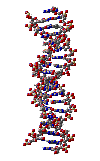|
How to follow proteins’ interaction inside the cells; a major step for the study of Parkinson’s and Alzheimer’s disease (09/2006)
For the first time scientists have succeed in developing a method that enables them to follow protein interactions directly inside cells. The discovery, now published in the FASEB Journal 1 has crucial implications for the study and treatment of those neurodegenerative illnesses - such as Parkinson’s, prion or Alzheimer’s diseases - which are known to result from aberrant protein interactions and deposits. In fact, the new technique, which the researchers test by studying the protein believed to be behind Parkinson’s disease, shows important potential not only to understand the mechanisms behind this type of diseases but also allows to observe, directly in the cells affected, the action of potential new treatments.
Parkinson’s disease (PD) is a progressive neurodegenerative disease characterised by increasing motor problems that can render the patient totally dependent of others for everyday tasks. The illness is believed to result from the loss of specific neural cells in an area in the brain - called substantia nigra - involved in motor function. These specific neuronal cells produce dopamine, a neurotransmitter used for the communication between the different parts of the brain involved in coordination and movement, and their death leads to interruption of the nervous signal and, ultimately, to the motor problems observed in PD patients.
Many neurodegenerative diseases, including PD, result from incorrectly folded proteins - all proteins have a specific shape/folding associated with their normal function – that either by becoming toxic, or by getting clumped together into insoluble aggregates, provoke the death of the brain cells in their surroundings. In the case of PD, the protein responsible for the pathology is believed to be alpha-synuclein, a brain protein of unknown function found in high quantities around the brain lesions of the subtantia nigra. Recently it has also been found that mutations or multiplications of the alpha-synuclein gene are responsible for some forms of Parkinson’s disease.
PD treatment and prevention is a medical priority in developed countries where the disease affects a striking 3% of the population above 65 years old, raising crucial financial issues especially as in these societies expectancy of life is steadily increasing and with it will also disease cases.
However, until now the understanding of this type of neurodegenerative diseases has been a very slow process due also to the lack of processes that could allow the observation of proteins directly inside the cell. But the development, by Jochen Klucken, Tiago F. Outeiro, Bradley T. Hyman and colleagues from the Massachusetts General Hospital, US and the University of Regensburg, Germany, of a technique called “Fluorescence Lifetime Imaging Microscopy” might change radically this. The new method consists in tagging the two ends of a protein with coloured dyes, which emit different energy specific wavelengths that can be read by a machine. The logic behind the technique is that the closer the two ends of the protein are (and so the two dyes), the higher is the interference between the two emitted wavelengths, allowing to infer if the protein has an open shape, is enrolled within itself or clotted together with other tagged proteins. This is crucial information as the same protein folded differently can have totally different effects/functions within the cell (it can even become toxic).
Using the new technique Klucken and colleagues studied alpha-synuclein in human cells and discovered a new aberrant interaction between different molecules of alpha-synuclein, which is probably involved in some forms of PD.
Even more interesting, the researchers were able to see inside the cell how the chaperone protein Hsp70 - chaperone proteins are molecules whose function is to assist other proteins achieving a proper folding – reverts alpha-synuclein toxicity.
In fact, although no cure for PD has been found so far, very promising work in animals and cells in laboratory has found that Hsp70 is capable of eliminating alpha-synuclein toxicity and so (theoretically at least) might help control the disease.
What the researchers now found was that Hsp70 opens alpha-synuclein misfolded structure allowing it to then revert to its normal (benign) shape. This result not only explains the mechanism behind Hsp70 protective effect, but proves that Fluorescence Lifetime Imaging Microscopy can be used to test new therapies in neurodegenerative diseases by directly accessing their effect inside the cells what is exciting news for both researchers and patients

1 The Federation of American Societies for Experimental Biology Journal (2006) “Detection of novel intracellular alpha-synuclein oligomeric species by fluorescence lifetime imaging”
Authors of the original paper - Bradley T. Hyman1 - bhyman@partners.org
|
In collaboration with the Observatório da Ciência e do Ensino Superior (OCES)
Financed by the Fundação para a Ciência e Tecnologia (FCT) |





